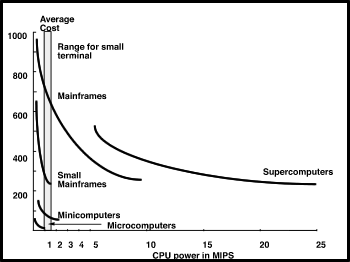
Landside Information Control
Computer Hardware
Computer Hardware
Historically the processing power of a computer has been measured
by the number of instructions the computer could process in a unit
of time, usually measured in MIPS (millions of instructions per second).
Grosch's Law
In the 1940's Grosch noticed that if a machine of processing power of 1 MIPS cost $1, then a machine with twice the processing power only cost $1.50 [reference 9]. This observation was canonized in the literature as Grosch's law and was the economic basis upon which all computing power in an organization was centralized. A recent study [reference 10] initially showed that this trend had reversed. Additional analysis concluded that the cost of computers still follows Grosch's law, but that computers are now segregated into 5 cost categories (see Figure 1). This study provided the economic explanation for the decentralization of computing power that is currently underway in industry. The study concludes that:
- A viable computer for a particular task should be selected from the least cost computer category, i.e. the most economical computing is done in the least cost category.
- The computer purchased within the category should be the largest affordable, since the incremental cost of processing power, or MIPS, is reduced by the square of the cost.